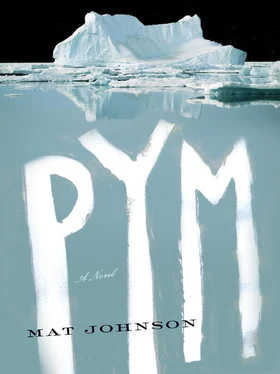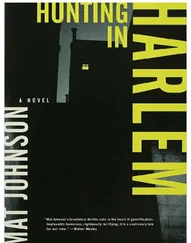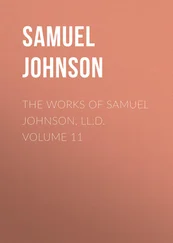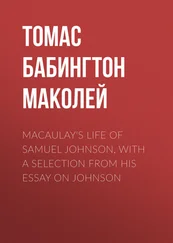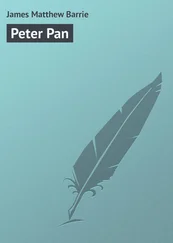His wool was perfectly white, and very coarse, curling tightly. The eyes were of a blood red, and larger than those of the Arctic bear — the snout also more rounded …
Tight, curly hair and a round nose … on a polar bear? Right. Strange things to imagine, particularly together. Makes you (me) wonder, who else is known for tight curly hair and round noses, whose attributes might have inspired Poe, consciously or sub? This improbable bear is, of course, just a teaser in his symbolic offering. One of many, along with Pym’s growing descriptions of the massive black albatrosses which haunt the Jane Guy , or the black and white penguins whose rookeries seem to offer a chance of order between this visual dichotomy. The real treasure comes at the arrival at the island of Tsalal, which despite being floating distance to the Antarctic continent, is a tropical land, well populated and idyllic in a way that harkens back to Diderot’s Tahiti. Except this island is not populated by a previously unknown enclave of Polynesians, or an even less probable lost tribe of hot-weather Inuits. No, the inhabitants of Tsalal are Negroes.
They were about the ordinary stature of Europeans, but of a more muscular and brawny frame. Their complexion a jet black, with thick and long woolly hair. They were clothed in skins of an unknown black animal, shaggy and silky, and made to fit the body with some degree of skill, the hair being inside, except where turned out about the neck, wrists, and ankles. Their arms consisted principally of clubs, of a dark, and apparently very heavy wood.
Not just skin of black, which is the classic European mythic negative, but woolly hair to match. These brothers are black. These brothers are so black they wear only the skins of animals that are black. The only wood they carry is darker than ebony. These brothers are so black, we eventually find out, that even their teeth are black. †In fact, the entire island of Tsalal is hued in shades of blackness. Poe leaves no detail unturned in his assertion of Tsalal as a fantastic place; even the water is poured into this metaphorical construct:
It was not colourless, nor was it of any one uniform colour — presenting to the eye, as it flowed, every possible shade of purple.… Upon collecting a basinful, and allowing it to settle thoroughly, we perceived that the whole mass of liquid was made up of a number of distinct veins, each of a distinct hue; that these veins did not commingle; and that their cohesion was perfect in regard to their own particles among themselves, and imperfect in regard to neighbouring veins.
The water is purple, a product of the mixes of the shades of white and black. The water’s veins hold up even when a knife cuts through it. So many shades yet they do not “commingle,” they exist separate but equal. Connected but completely disconnected. Metaphorically, it is synonymous with the racial fantasy that Booker T. Washington would put forth so many decades later in his “Atlanta Compromise,” that all Americans will be a fist of strength together, but in socializing we’ll be as racially segregated as the fingers of a hand.
The island of Tsalal offers horror, clearly, immediately. These black people — and it is a stretch to call these people “people,” with their animalistic primitivism and baby talk — are clearly horrors from the pit of the antebellum subconscious. And yet still for me, despite the filter, on my first reads through there was simply wonder at the thought of a lost tribe of Africans, even one distorted through the eye of the paranoid myopic vision of a white pro-slavery southerner. Tall, athletic — Yoruba, Igbo? Hair long and woolly — like dreadlocks? To me the Tsalalians were real but obscured and caricatured, hidden from our view in the erratic work of a drunken, pretentious madman. This is an American thing: to wish longingly for a romanticized ancestral home. This is a black American thing: to wish to be in the majority within a nation you could call your own, to wish for the complete power of that state behind you. It was the story of the maroons and black towns on the frontier, it was the dream of every Harlem Pan-Africanist. Tsalal —put it on your tongue and let it slither.
Immediately, the Tsalalians betray an aversion to all things white, manifested in their reaction to the skin of the Jane Guy ’s passengers. Of course, the complexions of the mates of the Jane Guy (not including Dirk Peters of course) would probably be more of a pinkish beige. Yet the Tsalalians react to their metaphorical Whiteness. It’s as if, as cut off as they appear, the Tsalalians already seem to know of the larger colonial struggle, understand that they should fear the infection of the Europeans’ amoral commerce. Of Whiteness as an ideology. And of course, the Jane Guy brings that pathology with it, immediately setting about building a production plant to process Tsalal’s natural resource of bêche-de-mer , or sea cucumber, for trade on the world market. True to form, not only do the colonial Europeans instantly commodify paradise on arrival but after they have begun the rape of Tsalal’s natural resources, they get the Tsalalians themselves to contribute the hard manual labor.
The chief of the Tsalalians, Too-wit, goes along with this invasion, acquiescing, having his people offer not the slightest resistance. On the surface, it appears another case of Enlightenment man, armed with only the products of his rational brain, conquering the ignorant savages despite their superior numbers. Too-wit, however, lives up to his name and, after a month of shucking and jiving for the invaders, leads the men of the Jane Guy and their false sense of security into a narrow pass. Once the crew is vulnerable there, Too-wit has his warriors cause a landslide to kill the lot of them. ‡
Amazingly, two people survive this unforeseen attack. Less amazingly, those people are Arthur Gordon Pym and Dirk Peters. Stunning no matter how many times you read it: after the attack has happened and the rest of the crew have been killed, after Pym realizes he is stuck on an island overrun with super niggers, he looks at the man he referred to as both a “half-breed” and a “demon” just a few pages before and says:
We were the only living white men upon the island.
Fascinating. Whiteness, of course, has always been more of a strategy than an ethnic nomenclature, but Dirk Peters’s caste shifting so quickly, so blatantly in reaction to the current dilemma is still something spectacular to behold.
When Pym and Peters return to the shore, they find the Tsalalians in a panic as these natives examine the corpse of that white polar bear thing, having pulled it from the now ransacked Jane Guy . And this, having taken the long route of entry, is where I first encountered the cry.
“Tekeli-li! Tekeli-li!” they scream.
Clearly this references something, something white and petrifying because, after being taken prisoner, this Tsalalian shouts the same expletive in response to the white linen shirts Pym and Peters use to construct a sail for their getaway canoe. The Tsalalians, having blown up the Jane Guy because of their primitive incapability to negotiate technology (and in the process having killed a thousand of their own people), are soon far behind Poe’s heroes, as the two men and one petrified Tsalalian hostage sail southward.
Oddly enough, the greatest allure of The Narrative of Arthur Gordon Pym of Nantucket comes from these final pages, from this ending. And it comes not from what Edgar Allan Poe does with the finale but from what he won’t do.
After drifting uneventfully along in this canoe toward the Antarctic, the narrative breaks into dated, diary mode. As their black Tsalalian hostage fades further toward death the closer they get to the polar whiteness, we’re left with this final paragraph, a complete daily entry in a novel that has suddenly reverted to journal form:
Читать дальше
